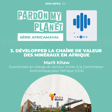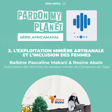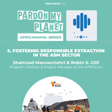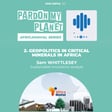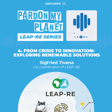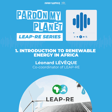Become a Creator today!Start creating today - Share your story with the world!
Start for free
00:00:00
00:00:01

Urban Forests & Nature-based Solutions
According to a report by the United Nations, it is said that 70% of the world population will live in urban areas by 2050. And with the expansion of urbanised spaces comes the challenge of not only protecting but also reintroducing nature in cities. Where do we find enough funding and do we convince investors that it is the future of cities?
Pierre Cattoire, Sustainable Innovation Strategist at LGI, is the guest of Pardon My Planet podcast. He leads a study for Clearing House, an European-Chinese project that aims to bring the forest and nature inside the cities. This study especially focuses on business models and investment cases for urban forest Nature-based Solutions (NbS).
More information on: lgi.earth/podcast
Transcript
Introduction to Urban Forest Solutions
00:00:10
Speaker
Hello and welcome to Pardon My Planet podcast. I'm Anshalot, your host. And today we will talk about urban forest nature-based solutions.
Challenges of Urbanization and Nature Integration
00:00:18
Speaker
According to reports by the United Nations, it is said that 70% of the world population will live in urban areas by 2050.
00:00:27
Speaker
And with the expansion of urbanized spaces come the challenges of not only protecting but also reintroducing nature in cities.
Funding and Investment in Urban Forests
00:00:35
Speaker
Saying that, where do we find enough funding and how do we convince investors that it is the future of cities?
00:00:42
Speaker
To answer this question, we welcome Pierre Catois, Senior Sustainable Innovation Strategist at LGI. He leads a study for Clearing House, a European-Chinese project that aims to bring the forest and nature inside the cities. This study especially focuses on business models and investment cases for urban forest nature-based solutions. Hello, Pierre. Hello, Anne Charlotte. Thank you for the invitation.
00:01:07
Speaker
And thank you for being here.
What are Urban Forest Nature-Based Solutions?
00:01:09
Speaker
First question maybe is to define exactly what is the urban forest, nature-based solution? Because in my mind, we talk about forests, I see at least central park size forests. Absolutely. It's a great example that people usually go to. An urban forest as a nature-based solution is a very important terminology that we need to dissect. On one side, you have the nature-based solution.
00:01:34
Speaker
I would urge anyone listening to have a look at the generally approved definition of an nature-based solution by the IUCN. But to drill it down, it's really all about bringing nature back to where it's needed most to provide solutions to our human challenges.
Benefits of Urban Forests
00:01:53
Speaker
The planet will survive us. So it's more about how do we use nature, take care of nature for our own benefit and to provide solutions to problems that we're facing as humans.
00:02:05
Speaker
One of the solutions is trees, forests, and we know this very, very well now. One of the specific solutions that we can have in urban spaces in particular is implementing or at least taking care of existing urban forests. So bringing in trees back into the cities and taking care of them to provide a lot of benefits and not just carbon capture, but also social
00:02:31
Speaker
and health benefits and biodiversity protection benefits.
Guidance for Urban Forestry Entrepreneurs
00:02:37
Speaker
Let's say it's great and we want to build this urban forest in our city, but where do we start and the prerequisites that we need to have in mind when we want to start this type of project? A lot of entrepreneurs have come to us or have come to the project with the key question of, hey, I want to do something, where do I start?
00:02:58
Speaker
The best thing that we tell them usually is, first of all, let's take stock of what we have. When we are in urban spaces and we have that luck in Europe and in China as well, to have a space that has been urban planned for centuries, we usually have urban forests already in place. And sometimes we have very large forests already in place outside of the big cities. The first thing to do is to protect those and take care of those. That's part of
00:03:26
Speaker
urban forest as nature-based solutions, protecting what we already have and making sure that it keeps doing its job and maybe even better.
Exploring Different Urban Forest Sizes and Types
00:03:35
Speaker
Another way to approach this is new forests. Now we must always be careful not to replace something existing that would best serve another problem. So maybe the solution that we want is the one of urban forests, but maybe it's not the solution that the space needs.
00:03:55
Speaker
So always consider the environment where the urban forest would be implemented, first of all. Once we have that, it doesn't matter the size. We have seen tiny forests, which is something that comes from Japan, which, you know, there was a big boom in those implementations around 10 years ago, and it's still ongoing a little bit today. Two, you know, very large forest like urban forest, like Central Park that you mentioned before.
00:04:22
Speaker
Again, Central Park has been there for ages and it has a very strong life. Another example that I like to give is the one of London where I lived a little bit.
00:04:31
Speaker
where the city, of course, is a megalopolis, very big, but it's also legally recognized as a park because of all the trees and the smaller parks that there are all around the Greater London area. So it is perfectly possible to have smaller urban forests, very large spaces dedicated specifically to forests, as well as patches of forests around cities. And all of those would be considered a great
00:05:02
Speaker
improvement to what we currently have.
Financing Urban Forests: Opportunities and Strategies
00:05:04
Speaker
And once we have found this space and exactly defining our project, most of the time the main issue in the project is how much money we can dedicate to this project. So if you want to finance this type of urban forest, where do we start and who do you turn to usually? Yeah, that's the age old question of who's going to pay me for the great thing I'm doing.
00:05:31
Speaker
For that, it's always the same as for entrepreneurship or any great enterprise that we want to start. It's start with purpose. It might seem like a blanket statement, but when we look at an urban forest, there are really two purposes, two big purposes. There's the social purpose and there's the private purpose or the economic purpose. When we look at a forest for its social benefits primarily, usually those forests are going to be
00:06:02
Speaker
started and managed by public entities, including cities and the people. Sometimes they also involve the NGOs. And as they keep growing, they can work with additional stakeholders. Another approach is to have a more private or maybe a more economics oriented, let's say, project, which is, oh, we're going to build a
00:06:26
Speaker
forest, but we're going to make a return on investment from that space. We're not just going to build a forest for the sake of it. And that's also a very fair approach. In that case, usually we have seen so far that NGOs and foundations have been project owners quite a lot. We do have a few entrepreneurs that we have seen that are trying to do urban forest. Usually it's easier for them to go on to other nature-based solutions because an urban forest is usually
00:06:56
Speaker
Even small, it is still a dedicated space. Whereas if you go for another urban nature-based solution, you could go, for example, for green walls or green roofs, which are easier to implement rather than dedicating a specific space for it. The argument of return on investment then is not really the one you should bring forward when you try to convince investors to build an urban forest.
00:07:26
Speaker
There's a lot of assumptions. This is definitely one of them. One of the assumptions is, oh, there's no money to be made. Or, oh, it's going to take a very long time to make money. It's fair to say that it's going to take longer, that's for sure. So far, I don't think it's fair to say that there is no money to be made. It's not a purely social, it doesn't have to be a purely social approach.
00:07:48
Speaker
There's many business models that have been developed around urban forests, including smaller urban agriculture, tourism, a lot of green long-term financing, carbon capture is definitely a big one out there. And then when we compare that to all of the benefits that are brought by urban forests, the cost is very small. Even for upkeeping this forest? Very good question.
Innovative Trends in Green Finance
00:08:14
Speaker
Yeah, upkeeping is definitely one of the bigger
00:08:17
Speaker
Things that we need to consider. The problem with upkeeping is timeline. Because the cost itself, of course, taking care of forest takes a lot of time, the cost of maintenance itself can be planned and prepared for long-term in advance. However, if we want to have a forest that is useful for the local population and in the long-term, then we need to look for
00:08:44
Speaker
you know, very long timelines, 20, 30, 50 years. And that's where maintenance starts to really build up as a very important item in a project balance sheet.
00:08:56
Speaker
And from what I hear, it can be challenging also to find this type of investors. Is there maybe any way? Because I think in the report that you've been doing for the Clearinghouse project, you have also noticed new ways of bringing the type of investments that is needed for the whole life of the project. Maybe can you elaborate a bit on that?
00:09:20
Speaker
Absolutely. It's a very interesting topic because we're in an interesting phase of finance and green finance in general. There's a lot of movement. There's a lot of regulation coming around. And with that regulation, we are seeing a lot of new products being implemented.
00:09:37
Speaker
Fairly historically, let's say, bonds have always been a very strong way to finance forest for over the long time. It's also a fairly good return on investment. It's stable, and it's a contract. So by law, it's going to be reimbursed in some way or another just to simplify. Then, of course, came about the green bond principles, and now we have green bonds that are dedicated specifically to green projects. So that has seen its big boom into that investment space.
00:10:07
Speaker
of nature-based solutions in general, let's say. Now, since 2014-2015, we're seeing a lot of new technologies come about which are also facilitating the relationship between the project owner and potential investors. You have the institutional investors and the individual investors.
00:10:28
Speaker
You could look at crypto. It's something that's starting to work. We don't have the results of those projects yet, like on the very long term. We don't know if they survive, basically, the investment phase. But we know that they can raise funds, even if it's not a lot. Usually it's in combination with other ways of raising funds.
00:10:47
Speaker
And you can look at crypto, you can look at new other different tools. You could look at the pure private equity approach of building a private company and raising private equity for having a bunch of investors. We also have blended finance, which is a very big topic, leveraging development, in particular, development finance to attract, well, first of all, to strengthen and stabilize
00:11:15
Speaker
a long-term investment project, but then to be able, through that stability, to work with private investors. We're seeing this more and more, usually geared towards developing countries because it is developed in finance, but the approach of combining public and private financing streams can be a very strong approach. Although there might be tens of ways to raise funds and or generate revenue, it's always going to be about purpose.
00:11:44
Speaker
As long as you have a purpose that is clear and you build a virtual table with all the right stakeholders around, investors are going to be willing to pay for it. It's all about purpose. If you go to anyone in the street and you ask them to invest in a tree, more often than not, they will want to. And they will not care about whether it's crypto or a bond or anything else. They will care about the project itself.
00:12:10
Speaker
which is clearly the most important part for
Successful Projects and Future Directions
00:12:14
Speaker
sure. In this report that you've made, do you have any example of this, of real life, we can say, examples of what has been successful in building this urban forest? And also, if this type of models, it can be easily replicated to other cities? Yeah, so it's fair to say that every type of project is going to be slightly different. You know, every environment is a different environment, basically. Still, there are some rules
00:12:40
Speaker
To answer your question fully, yes, we do have quite a few examples. First of all, the Clearinghouse project itself is built upon five case studies in Europe and five case studies in China, and we're learning from all of those case studies. In all cases, those case studies are dedicated spaces for this project, and they're being heralded by cities, so public entities. But they still give a lot of insights to private investors or private project owners who want to learn
00:13:10
Speaker
about this project. So those are great examples. In the report, we also have a lot of interviewees from the public and private space as well. And they provide a lot of examples from their own portfolio of projects and investments. And we do see some private ones are working really well, and some public ones are working really well. In all of those projects, of course, there's lots to be learned.
00:13:36
Speaker
challenges to be overcome, but in the report we are doing our best to extract the knowledge that has been built by those case studies and those projects as lessons learned, if you will, for future projects.
00:13:51
Speaker
Thank you very much, Pierre, for answering our questions. And if you want more information about this report and also the different challenges around urban forest, you can check out LGI website as well as clearing a house website. Thank you very much, Pierre. Thank you, Anne-Charlotte. And thank you for listening to Pardon My Planet podcast. We'll see you in the next episode. Thank you very much.
